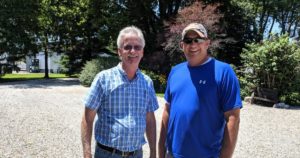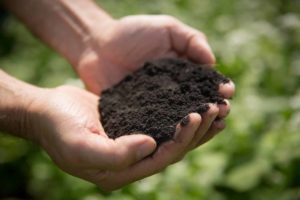Finding a Way Forward
Building soil health is helping some farmers manage their farm despite current low prices and high input markets and increasing wet springs and dry summers. We learned about The Martin Family’s farm transition from conventional to regenerative farming practices that improve their soil here.
However, not all farmers are moving in this direction. Conservation farming practices are not as common as they need to be to protect our water and soil for the future. So far, only two to three percent of crop acreage in Illinois has cover crops. We need something like 80 to 100 percent of acres to have cover crops on them. We need to increase by 2 to 3 percent every year.
 Jeff Martin finds, only 5% of farmers are willing to listen about soil health. The other 95% think we’re crazy. Most farmers are nearing retirement and resist making big changes to their operation. With the average age of farmers is near 60, this can affect a large portion of farmers. Others may see some of the benefits but say, that’s for the young farmers, and resistant to learning new management strategies and equipment when they are nearing retirement.
Jeff Martin finds, only 5% of farmers are willing to listen about soil health. The other 95% think we’re crazy. Most farmers are nearing retirement and resist making big changes to their operation. With the average age of farmers is near 60, this can affect a large portion of farmers. Others may see some of the benefits but say, that’s for the young farmers, and resistant to learning new management strategies and equipment when they are nearing retirement.
Learning new farming practices is as much about changing social norms as about the science of building soil health. Even the language around agriculture supports conventional methods and ideas. For example, crop residue, which protects the soil and feeds the soil biology is commonly referred to as trash. This terminology reinforces the conventional ideal of a “good” farmer having a flat, black tilled field with no residue and neatly mowed ditches. In many ways, conservation farming practices are messier. Cover crops can be mistaken for weeds; untilled fields are covered in residue. It can be a completely different way of thinking.
Educating the Next Generation of Farmers
The Martins see more hope with the next generation who will be more concerned with how they are going to sustain their farm for the next 40 plus years with low prices, high inputs, and wet springs. Derek Martin says educating people about soil health is the key to getting more farmers and landowners interested in these practices.
Our main agencies educating farmers about conservation practices are the USDA’s Natural Resource Conservation Service who along with the Farm Service Agency manages our farm bill conservation programs, and our local Soil and Water Conservation Districts (SWCDs). Our SWCD’s both run our state conservation cost share program and provide educational opportunities in the farm community about conservation practices like reduced tillage and cover crops. Practices that improve soil health also improve water quality.
 The Martins worked with their local Soil and Water Conservation District (SWCD) to enroll in the Conservation Stewardship Program which provided cost-share and technical assistance while they learned how to incorporate cover crops into their farming operation. Jeff Martin says, “Steve has always been a part of their team of people they go to when tackling new problems or trying new practices,” referring to Logan Co. SWCD staff, Steve Bracey. The Martins have seen dramatic improvements in their soil and crops and now after starting with just 40 acres of cover crops, have over 3,000 acres converted.
The Martins worked with their local Soil and Water Conservation District (SWCD) to enroll in the Conservation Stewardship Program which provided cost-share and technical assistance while they learned how to incorporate cover crops into their farming operation. Jeff Martin says, “Steve has always been a part of their team of people they go to when tackling new problems or trying new practices,” referring to Logan Co. SWCD staff, Steve Bracey. The Martins have seen dramatic improvements in their soil and crops and now after starting with just 40 acres of cover crops, have over 3,000 acres converted.
Conservation programs like the ones that helped the Martin’s have struggled with budget cuts and consolidation. During the Illinois budget crisis starting in 2015 we lost half of our SWCD staff leaving many districts understaffed. While Logan Co. is doing better than many Counties, Steve, Logan Co. Resource Conservationist, says they’ve had to do more with less and are often not able to spend as much time on educational events. This is further compounded by consolidation within the federal conservation programs.
Despite these challenges just waiting for the next generation to take over farming is not an option. Every year we accumulate more damage from communities having to buy nitrate treatment facilities to the loss of wildlife and industry in the gulf hypoxic zone. It is also hard enough for young farmers to start up, especially beginning farmers. And with fewer staying on the farm with each generation we need to give them all the help we can. It is too much to ask them to shoulder the whole transition to regenerative agriculture. We need the transition to start now.







